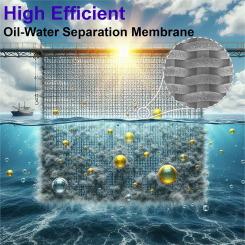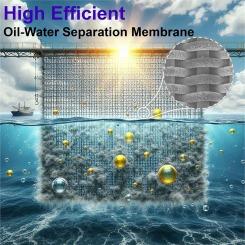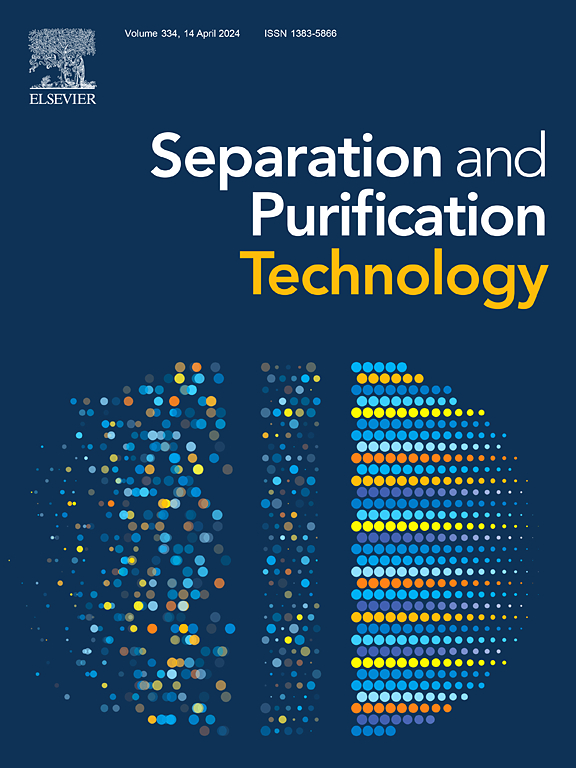Robust and efficient oil-water separation using candle soot deposited stainless steel mesh
IF 8.1
1区 工程技术
Q1 ENGINEERING, CHEMICAL
引用次数: 0
Abstract
In recent years, the rising concerns regarding oil pollution and the emissions of organic pollutants from industrial activities have posed significant environmental and public health challenges. The treatment of oily wastewater and organic pollutants has emerged as pressing issue, necessitating the development of efficient solutions. Oil-water separation stands out as a promising approach to address these challenges. However, the effictiveness and robustness of the separating membranes have been identified as key limitations hindering the advancement of oil–water separation technologiess. This paper introduces a novel superhydrophilic/underwater superoleophobic membrane tailored specifically for oil–water separation with enhanced water flux. This film is prepared by depositing candle soot on a stainless steel mesh and then polymerizing phytic acid (CSM-PA). The contact angle of CSM-PA membranes underwater for a wide range of oils is above 140°, reaching a maximum of 152.73°. The CSM-PA membrane demonstrates excellent separation performance for various oils, achieving separation efficiencies flux surpassing 99.990 %, achieving separation efficiencies flux surpassing 18950.360 L·m−2·h−1. Notably, the membrane exhibits contact angles under water exceeding 142° for all oils tested. After conducting immersion, sand impact, and water impact tests, the underwater contact angle for both light and heavy oils was found to exceed 139°. The surface roughness of the CSM-PA film on the initial stainless steel mesh improved significantly, increasing from 106 nm to 452 nm. Impressively, even after 70 cycles, the CSM-PA membrane maintains an oil (n-hexane) water separation efficiency exceeding 99.997 % and a remarkable flux rate of 21055.956 L·m−2·h−1, the maximum separation flux is even 29154.400 L·m−2·h−1. Furthermore, the CSM-PA membrane shows significant stability and resistance to mechanical abrasion, ensuring long-term and reliable operational performance. The findings of this study hold significant implications for the advancement of oil–water separation technologies, offering a promising avenue for addressing oil pollution and organic pollutant emissions in a sustainable and effective manner.


利用烛烟沉积不锈钢网实现稳健高效的油水分离
近年来,人们对石油污染和工业活动排放的有机污染物日益关注,这给环境和公共卫生带来了重大挑战。含油废水和有机污染物的处理已成为亟待解决的问题,需要开发高效的解决方案。油水分离是应对这些挑战的一种可行方法。然而,分离膜的效率和坚固性被认为是阻碍油水分离技术进步的主要限制因素。本文介绍了一种新型超亲水/水下超疏水性膜,专门用于提高水通量的油水分离。这种膜的制备方法是在不锈钢网上沉积蜡烛烟灰,然后聚合植酸(CSM-PA)。CSM-PA 膜在水下与多种油类的接触角均超过 140°,最大可达 152.73°。CSM-PA 膜对各种油的分离性能优异,分离效率通量超过 99.990%,分离效率通量超过 18950.360 L-m-2-h-1。值得注意的是,该膜对所有测试油类的水下接触角均超过 142°。在进行浸泡、沙击和水击试验后,发现轻油和重油的水下接触角都超过了 139°。初始不锈钢网上 CSM-PA 薄膜的表面粗糙度明显改善,从 106 nm 增加到 452 nm。令人印象深刻的是,即使经过 70 次循环,CSM-PA 膜的油(正己烷)水分离效率仍超过 99.997 %,通量率达到 21055.956 L-m-2-h-1,最大分离通量甚至达到 29154.400 L-m-2-h-1。此外,CSM-PA 膜还具有显著的稳定性和抗机械磨损性,可确保长期可靠的运行性能。这项研究的结果对油水分离技术的发展具有重要意义,为可持续、有效地解决石油污染和有机污染物排放问题提供了一条前景广阔的途径。
本文章由计算机程序翻译,如有差异,请以英文原文为准。
求助全文
约1分钟内获得全文
求助全文
来源期刊

Separation and Purification Technology
工程技术-工程:化工
CiteScore
14.00
自引率
12.80%
发文量
2347
审稿时长
43 days
期刊介绍:
Separation and Purification Technology is a premier journal committed to sharing innovative methods for separation and purification in chemical and environmental engineering, encompassing both homogeneous solutions and heterogeneous mixtures. Our scope includes the separation and/or purification of liquids, vapors, and gases, as well as carbon capture and separation techniques. However, it's important to note that methods solely intended for analytical purposes are not within the scope of the journal. Additionally, disciplines such as soil science, polymer science, and metallurgy fall outside the purview of Separation and Purification Technology. Join us in advancing the field of separation and purification methods for sustainable solutions in chemical and environmental engineering.
 求助内容:
求助内容: 应助结果提醒方式:
应助结果提醒方式:


